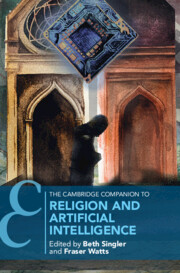Book contents
- The Cambridge Companion to Religion and Artificial Intelligence
- Cambridge Companions to Religion
- The Cambridge Companion to Religion and Artificial Intelligence
- Copyright page
- Contents
- Contributors
- Acknowledgements
- 1 Introduction
- 2 Steps towards Android Intelligence
- Part I Religions and AI
- Part II Social and Moral Issues
- Part III Religious Studies
- Bibliography
- Index
- Cambridge Companions to Religion (continued from page ii)
- References
2 - Steps towards Android Intelligence
Published online by Cambridge University Press: 20 November 2024
- The Cambridge Companion to Religion and Artificial Intelligence
- Cambridge Companions to Religion
- The Cambridge Companion to Religion and Artificial Intelligence
- Copyright page
- Contents
- Contributors
- Acknowledgements
- 1 Introduction
- 2 Steps towards Android Intelligence
- Part I Religions and AI
- Part II Social and Moral Issues
- Part III Religious Studies
- Bibliography
- Index
- Cambridge Companions to Religion (continued from page ii)
- References
Summary
This chapter reviews progress in the field of artificial intelligence, and considers the special case of the android: a human-like robot that people would accept as similar to humans in how they perform and behave in society. An android as considered here does not have the purpose to deceive humans into believing that the android is a human. Instead, the android self-identifies as a non-human with its own integrity as a person. To make progress on android intelligence, artificial intelligence research needs to develop computer models of how people engage in relationships, how people explain their experience in terms of stories and how people reason about the things in life that are most significant and meaningful to them. A functional capacity for religious reasoning is important because the intelligent android needs to understand its role and its relationships with other persons. Religious reasoning is taken here not to mean matters of specific confessional faith and belief according to established doctrines but about the cognitive processes involved in negotiating significant values and relationships with tangible and intangible others.
Keywords
- Type
- Chapter
- Information
- Publisher: Cambridge University PressPrint publication year: 2024

